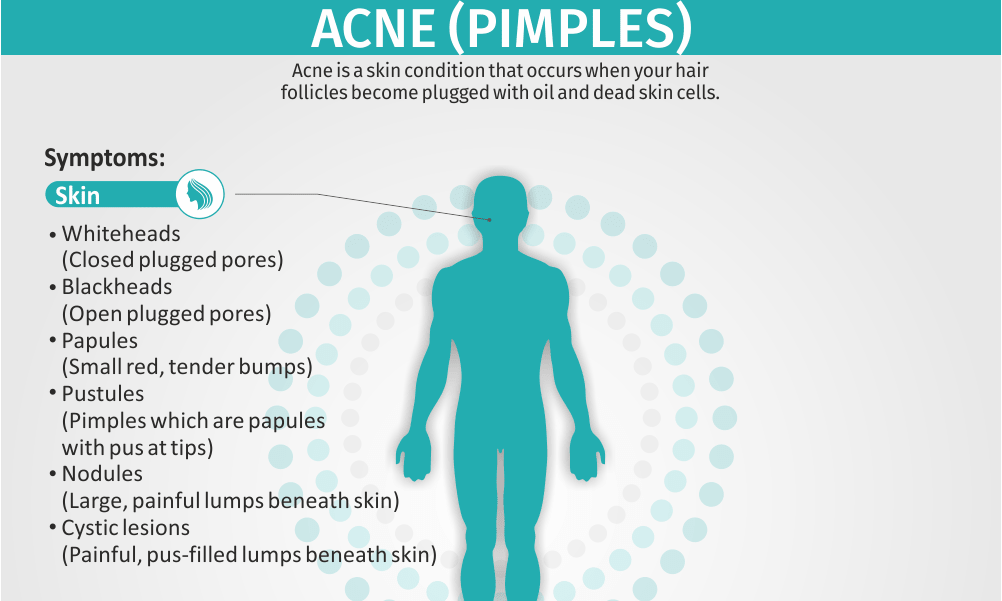Acne is a common skin condition which causes spots and pimples, particularly on the face, neck, back, shoulders, chest, and upper arms. Acne popularly happens in individuals who are going through puberty. Acne can be worse for people having oily skin.
Acne signs and symptoms vary depending on the severity of your condition
Acne typically appears on your face, forehead, chest, upper back and shoulders because these areas of skin have the most oil (sebaceous) glands. Hair follicles are connected to oil glands.
The follicle wall may bulge and produce a whitehead. Or the plug may be open to the surface and darken, causing a blackhead. A blackhead may look like dirt stuck in pores. But actually the pore is congested with bacteria and oil, which turns brown when it's exposed to the air.
Pimples are raised red spots with a white center that develop when blocked hair follicles become inflamed or infected with bacteria. Blockages and inflammation that develop deep inside hair follicles produce cystlike lumps beneath the surface of your skin. Other pores in your skin, which are the openings of the sweat glands, aren't usually involved in acne.
Just cutting out the damaging foods listed above will likely lead to clearer skin—especially if you were regularly consuming them before. But what if you’re already eating healthy? Are there certain foods that could give you the edge against acne? Research is in its earliest stages, but we do have some knowledge of particular foods that may help. Here are five of them:
The typical Western diet contains too many omega-6 fatty acids, which are tied to inflammation. Eating more omega-3 fatty acids, such as those found in fatty fish, walnuts, flaxseed, and the like, can help tame inflammation and improve acne breakouts.
Green tea is filled the antioxidants that can protect from environmental stressors. Drink more green tea throughout the day.
Eating more fruits and vegetables can naturally help clear up acne, and juicing is a great way to do so. Many contain beta-carotenes, which naturally help reduce skin oils, and all are naturally anti-inflammatory. Dark, leafy greens also help clear impurities from the body,
These have been found to reduce inflammation in the gut, which may help reduce acne. According to a 2011 study, intestinal microflora may affect inflammation throughout the body, which in turn, can affect acne breakouts. Since pre and probiotics can reduce inflammation and oxidative stress, scientists believe they may help reduce acne breakouts
Eat more oysters, toasted wheat germ (sprinkled on salads and steamed veggies), veal liver, roast beef, roasted pumpkin and squash seeds, and dried watermelon seeds
Aloe vera contains antibacterial properties, which help prevent the formation of cystic acne. Besides, it also contains essential minerals, vitamins, amino acids, proteins and enzymes, which are very good for skin.
Mix 1 tsp. of baking soda with some cucumber juice or plain water to create a thin paste.
Then, apply this paste on your affected area.
Leave it on for several minutes before rinsing it off with warm water.
Finally, use a moisturizer
Repeat this remedy once or twice per week.
turmeric works as a natural antiseptic to help you fight off infection.
However, when using garlic to treat cystic acne, discontinue right away if you notice skin redness and itching. Also, remember to protect the skin before going out.
This is worth mentioning in the list of home remedies for cystic acne on nose, cheek and forehead that you should consider making use at home. Using cucumber is known as one of the best home remedies for cystic acne thanks to its high content of vitamins A, B1, B2, C, iron, etc.
Studies so far have focused mostly on the foods that make acne worse. Here are the five that come up most often as culprits in increasing breakouts. Avoid these for about a week, and see if you notice a difference.
